- Article explains evolution and different types of the art, its application, revival by Santiniketan and pioneer Jamini Roy.
Folk
art has many forms in India but it is only in recent years that it has received
its due attention. In a nation that comprises so many states, each distinct
cultural and traditional identity is displayed in the folk art of the region.
Apart from this, each tribe also carries along with its traditions, art forms
that are unique to them known as tribal art. The state of West Bengal was one
of the first in the move towards recognizing and reviving its folk and tribal
art traditions.
In
fact, not one, but several forms of folk art originate from the Eastern region
of India comprising West Bengal, Orissa and Bihar.
Santhals
are the third largest tribe in India and are known for their unique form of
tribal paintings known as Santhal Tribal Paintings. Santhal tribes are
sustained by the forests and their occupations - farming, fishing, hunting which
revolve around the forests that they live in. After a long day at work they
retire for the day and find relaxation in music and dance.
The
inherent love of dance and music forms an important part of Santhal fairs and
festivals.
Themes
in Santhal paintings revolve around this community life especially celebrations
and rituals. Paintings depict dancing, harvest and merry making through enchanting
minimalist images in muted shades.
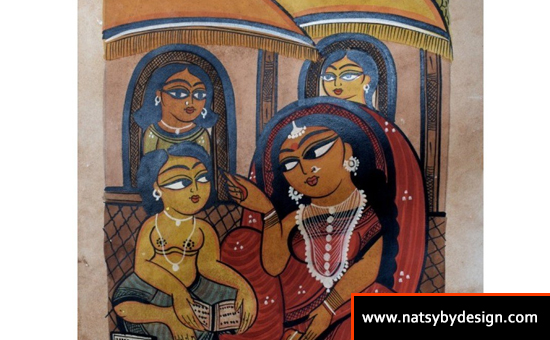
Reference
and Pic credits
Evolution of the art
Forms
of arts change from age to age according to changing outlook, circumstances,
methods and techniques. But folk art is brought into form in fidelity to
natural and biological laws, operating within ethnological and geographical
parameters.
Today
Santhal artists paint on canvases, using acrylic for exhibitions and for sale,
although the older generation still stick to their special colours obtained
from plants, mud and other raw materials. The simplicity, virility and vitality
of Santhal paintings, emerging from natural environs provide a fine chapter in
the history of Indian arts, and needs to be sedulously nurtured.
The
paintings are drawn by a special community called Jadu Patuas or magic painters in the Santhal Paragana district of
Bengal/Bihar borders. The painters are called magic painters because they paint
to preserve crops, avert diseases, honour the dead and so on.
Chakshudaan Pata, for example, a painting made for a bereaving family, is shrouded in magic and mysticism. When somebody dies in a village, the Jadu Patua visits the family with an image representing the deceased, but the pupil’s in the eyes of the image are missing. After the family makes a gift offering or daan to the Jadu Patua, he then performs the Chakshudaan or “bestowal of sight” by painting of the iris in the blank eyes of the portrait in order to free the dead person’s soul and send it to heaven.
These
paintings are nearly a world apart are the Kalighat style of paintings which
was born in the market places of Kolkata during the 19th century. It is said
that Kalighat paintings originated in the vicinity of the Kalighat Kali Temple
in Kolkata.
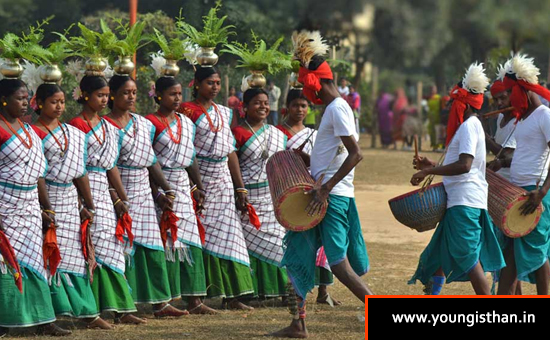
Pic
credits
The Application
The
Santhal folk painting, drawn by the Santhal tribes living in Bengal, is a
folk art with a distinctive style of their own. Here we see paintings where the
tribes are in musical procession or illustration of other simple themes like
harvest, family life, and rituals of their life.
The
Santhals paint in Pata or cloth.
These then form the scrolls which unfurl to tell a story. They take the
paintings from village to village not to sell their paintings but to get money
in form of donations by singing songs based on the stories. These songs are
known as Pater Gaan.
Santhals
earlier used natural colours which were prepared from various leaves and
flowers. But now they have started painting with synthetic paints on paper in
small and medium-size scrolls created by stitching two sheets of paper
together.
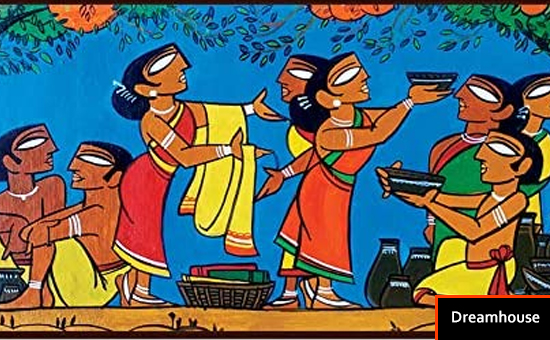
Pic
credit Dreamhouse and link
We know that Jamini Roy, one of India’s great artists was inspired by folk paintings of Bengal.
Though
we loosely refer these paintings as Santhal tribal painting or folk painting of
Bengal, their styles vary in form and application of colour from region to
region. Bankura, Midnapore or Kalighat have very different styles. Even the
themes distinctly differ. The bifurcations/ divide are as below:
Kalighat folk painting
The
Kalighat folk paintings have bold colours with strong definite strokes for outlines. There is a visual rhythmic movement of the people in the paintings. The side faced girls have a pleasant expression. Other than the people they also paint things that they use in daily life. Overall, the picture is busy and bright.
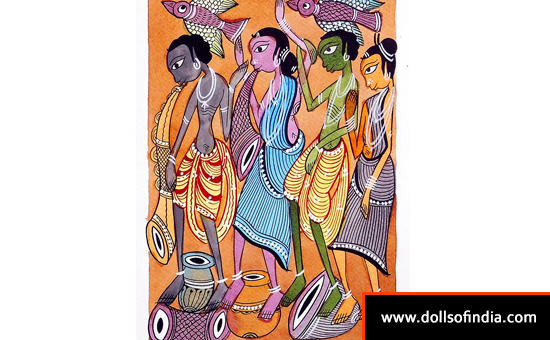
Pic
credits
Midnapore folk painting
The
Midnapore folk art, on the other hand, has finer lines and more detailed work.
They focus on a theme and paint around the theme. The paintings have fewer
colours as compared to the Kalighat painting and have a subtlety in their depiction.
The eyes are elongated covering almost the entire face.
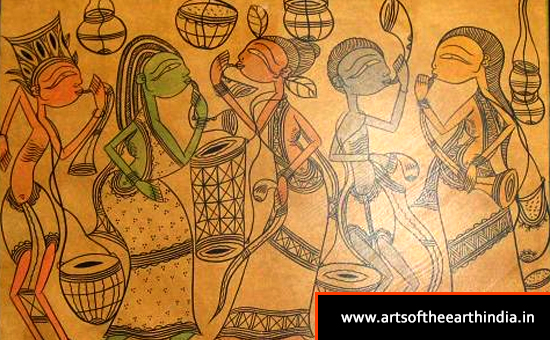
Pic
credits
The Implementation
The
Santhals paint the walls of their huts during their village festival for
ceremonial celebratory performances as also for self-expression. They worship a stone, as a formless representation of the
Divine, sing of the burthen of their life and provide a vivid portrayal
of their day-to-day experiences, shared by animals and birds.
Done
in primary colours, infested with leafy patterns in the foreground, background
and borders, the Santhal paintings are characterized by a directness and a
childlike simplicity in the depiction of birds, animals and insects. The
figures are static, frequently multi-colour, artistic rather than realistic
projections. Bodies of fish and birds are joined in one head.
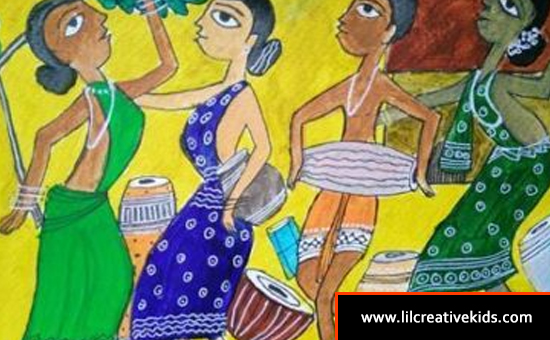
Reference and Pic credits
A set scenario
Mother
and child as well as human, animal and bird couples are brought together by a
philosophy of love and unions. A panoramic view of the village forms the
backdrop, with women carrying firewood and water, men driving the bullock cart
to the market, dancing and singing under a tree, a couple under flowering
creepers; a family going for cultivation; men and women cutting wood, gathering
fire wood, carrying water on the head; hunters returning with their catch ;
fishing; taking mud pots in a cart to the village market for sale, flying kites
and swinging, brothers of the bridegroom carrying the bride in a basket.
These
tell of the strong family bond and brimming with life diffusing a rare energy
that animates Santhal art.
The
colour scheme holds no logic. A bird or a fish appear in many colours. The
picture is first drawn in black and then coloured. Originally, the Santhals
used natural colours made from plants and stones, with a special and striking
tinge. The older generation still sticks to natural colours while the young opt
for synthetic colours. There also black and white paintings on canvas presented
for archives or for sale today.

Pic credits
Reviving Santhal Art (The main concern)
Revivalism in the visual arts coupled with the scholarly assessment of India’s ancient artistic heritage was a phase of India’s renaissance during the freedom movement. Over a period of fifteen hundred years, a continuous, consistent and ever-growing tradition had existed in arts. Glimpses of this continuity in painting are traceable in the present-day folk art, despite problems thrown-up by the confrontation of a traditional society with a technological age.
The pioneer
Jamini
Roy of the Bengal school, who, like many of his peers, understood the formal
qualities, was the first among his peers to recognize the vitality of the myths
and nature mysticism inherent in so called primitive and folk art. And he
forged ahead visualizing valid alternatives in this art to mainstream western
are introduced in the colonial period.
A
post-modern and a contemporary artist in this age, he brought the Vaishnavite,
Baul and Santal traditions visibility and precision in the world of art.
Santhal Tribal Art Painting (Visual Display)
The
stories are told in a series of simple clear-cut images. Trees, flowers or
rocks are depicted by simple diagrammatic forms. Figures are usually shown in
profile and color is used unrealistically for dramatic or poetic effect. All
pigments are traditionally derived from natural sources.
This
set of Santhal paintings, inspired by Indian rural or tribal life. Santhal is
an important tribe which contributes more than 50% of the Indian tribal
population. Santali culture is depicted in the painting set. This is a set
of 3 - charming Santal paintings of marriage celebration (in A3
size), celebration of life through beating music and dance (in A4 size),
fishing as livelihood (in A4 size).
In
the marriage celebration painting Bride and groom are being carried in a doli (palanquin). Basically, freehand
painted, this painting replicates their perception of life.
In
the celebration of life painting the Santal traditionally accompany many of
their dances with two drums: the Tamak
and Tumdak. The flute was considered
the most important Santal traditional instrument and still evokes feelings of
nostalgia for many Santal.
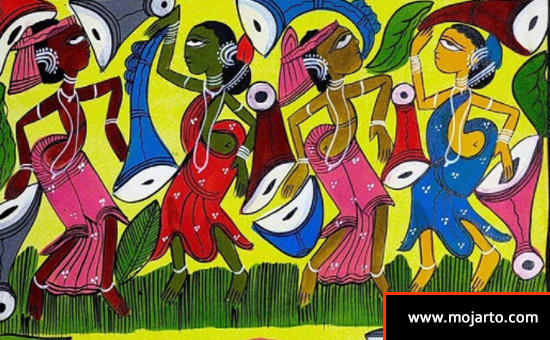
Pic
credits
The
other painting depicts the Santala performing their traditional
occupation fishing- catching fish from a village pond.
Basically,
freehand painted, this painting replicates their perception of life. The
paintings are traditionally made from handmade paper, backed with cloth. Santhal
Art is a notable art form, coming from the tribal villages of West Bengal.
These scrolls were visual accompaniments to stories told through songs and
ballads.
These
paintings are traditionally made with natural mineral and vegetable colours.
Delightful and earthy, these paintings reflect the ancient tradition of
storytelling in India. The tribal life of India has a lot of celebration in it.
Their eyes shine bright and their body language is full of life.
An
Institution Promoting the Art
Santiniketan,
a centre of excellence for Indian art, is associated with the iconic figure of
Rabindranath Tagore worldwide. The art of the Santhals gained prominence during
his days Tagore got interested in the Santhals living in a hamlet close to
Santiniketan and began to promote their art when he came across Nandalal Basu
and appointed him as art teacher in Kala Bhavan.
From this context arose an interest in folk arts and traditional crafts in Santiniketan and Sreeniketan. Soon an artist’s colony was established in 1930 near Santiniketan with Ramkinkar Baij, the Santhal painter and sculptor as one of its founding members. Today, those who visit Santiniketan come back with Ramkinkar indelibly etched in their memories.
Pic
credits
Art project in today’s times
Usually, one paint’s almost the same theme in two different styles of Santhal painting. One mainly learns to draw out the figures. Then we use watercolour paper and acrylic paints to paint. One can also use watercolour or poster colours too.
To see video of Santhal
Paintings Tutorial 10 minutes
The
purpose of this compilation is to document and promote. We have given credits
and reference links in this compilation. In case some are missed, it is not
with malafide intent.
To read all
articles by author